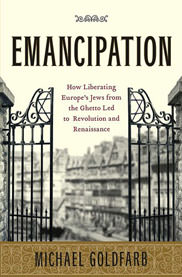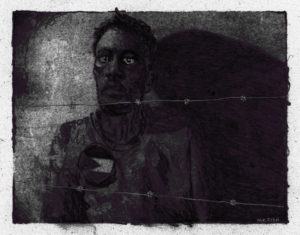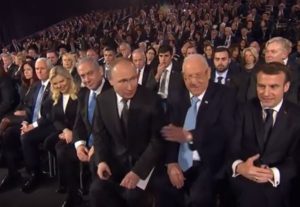Milton Viorst on the Emancipation of Europe’s Jews
A new book by Michael Goldfarb grapples with the fate of a people caught between hope and history.
Emancipation is the gift Europe offered the Jews as they entered into the modern world. It presumably meant an end to the restrictions that throughout the Middle Ages had kept them in ghettos and limited their everyday lives. It tantalized them with a vision of political and social equality. The most pious of Jews, advised by their rabbis to let God take care of them, dismissed the offer. But most others accepted it with gratitude.
Europe, however, did not bestow the gift with a warm heart. It was conveyed grudgingly, in small bits, and the bits were often snatched back. How nice it would to be to say that ultimately Emancipation triumphed, having survived the frame-up of Dreyfus in France, the abduction of Mortara in Italy, the murderous pogroms in the Russian Pale, the Holocaust perpetrated by Germans. Some Jews say that today anti-Semitism is dead at last. But many others remain skeptical, unconvinced that the fruits of Emancipation will not, under some pretext and in brutal fashion, again be yanked away.
Emancipation came as a byproduct of the Enlightenment, the intellectual wave that swept through Europe starting in the 18th century, breaking the back of feudalism. The ground for it was broken first by the Renaissance, exalting humanist values, then by the Reformation, shattering the church’s monopoly over men’s minds. Among its fathers was Spinoza, a Jew excommunicated for challenging rabbinic dogmas. He was followed by Descartes and Rousseau and Newton and Locke, who together replaced theology with reason at the center of European thought. Though directed at Christian society, the wave inevitably had an impact on how Europe’s Jews thought of themselves.
Emancipation: How Liberating Europe’s Jews from the Ghetto Led to Revolution and Renaissance
By Michael Goldfarb
Simon & Schuster, 432 pages
Jewish Emancipation was an organic product of the Enlightenment. Reason had led to a reverence for intellectual diversity, which in turn begat a tolerance that collided with the mindless anti-Semitism that for so long had been embedded in Europe’s culture. The momentum for Emancipation reached a pinnacle in the French Revolution and in the era of Napoleon, who carried the idea through Europe in the caissons of his armies. When Napoleon fell in 1815, the momentum slowed and in short order reversed its course.
Michael Goldfarb, a radio journalist with a taste for history, has written a nice book on Emancipation. It is “nice,” in being largely a series of bright, good-natured profiles of many of the fascinating Jews whose lives were remade by Emancipation, and who were disappointed grievously by the collapse of its promise. Goldfarb’s fascinating subtitle, “How Liberating Europe’s Jews From the Ghetto Led to Revolution and Renaissance,” is deceptive. The book, in not going beyond “nice,” fails to present Emancipation as a movement with social ramifications that profoundly changed Jewish destiny.
Throughout much of the 19th century, many Jews bravely resisted the erosion of Emancipation. Though unfamiliar with arms, they fought alongside liberal allies in the uprisings of 1830 and 1848, both of which ended in defeat. While Orthodoxy held stubbornly to its ancient practices, Jews shaped by Emancipation gave up Yiddish as their lingua franca, sent their children to secular schools and even formed new denominations to modernize the faith, all in the hope of attaining compatibility with Christian society. Their efforts did not work.
Goldfarb astutely points out that the Enlightenment taught much of Europe to be tolerant of Judaism but not of Jews, though he does not examine why. One answer seems to lie in the widespread rejection of clerical authority, making Christians more comfortable with Judaism as an alternate form of worship. So why were they so uncomfortable with Jews? The common answer is that, after Napoleon, European nationalism turned backward, replacing tolerance with a romantic tribalism based on race, from which it was easy to exclude Jews. Europe returned to the medieval identification of Jews as foreigners. But another major factor was the increasing dominance of capitalism, for which Jews seemed to have an aptitude, over static agrarian culture. Until modern times, ghettoized Jews had run their own school systems, in which virtually all their children learned to read. They had also developed a wide communications network for consultations on provisions of Jewish law. Some historians theorize further that Jews, used to the daily perils of anti-Semitism, were more comfortable with risk. Whatever the explanation, Jews were better prepared for the new money economy than their agrarian neighbors. Europe, however, resented their success, and in time its dormant anti-Semitism awoke.
And so Emancipation, buffeted by capitalism, retreated. More than a few Jews, recognizing its fragility, thought they would be protected by conversion. Among the most celebrated, and most sensitive, was Heinrich Heine, the brilliant German-Jewish poet, who is a favorite of Goldfarb. Heine quickly understood that his conversion had gotten him nothing and, in anger, he left Germany for the more liberal France. From Paris he wrote to an old friend, “I am now hated by Christian and Jew. I regret very much that I had myself baptized. … Since then, I have had nothing but misfortune.”
Emancipation: How Liberating Europe’s Jews from the Ghetto Led to Revolution and Renaissance
By Michael Goldfarb
Simon & Schuster, 432 pages
Emancipation suffered a near-fatal crash in 1881, when the czar’s government in Russia unleashed bloody pogroms on the Jews of the Pale of Settlement. Russia’s capitalism had produced unruly hordes of impoverished workers and peasants, who threatened the regime’s stability. When Czar Alexander II was assassinated — though the perpetrators were not Jews — his successor reasoned that he could pacify the hordes by turning them loose on the Jews. The bloodshed lasted for several years, undermining the conviction of Jews — especially of Enlightenment Jews — that they had a future in Europe.
That is when Russia’s Jews — my own grandparents among them — fell back on the Jews’ ancient practice of fleeing oppression, and began their mass exodus to America. Significantly, most Orthodox Jews, heeding their rabbis’ warning to shun godless asylums, remained; half a century later, they became Nazism’s principal victims. But many Enlightenment Jews, more psychologically than legally emancipated, made the unprecedented decision of taking Jewish destiny into their own hands.
Though the Enlightenment had failed to keep its promises to the Jews, it transformed Europe’s Jewish community. As no Jews before them, post-Napoleonic Jews were heavily secular, unwilling to submit to an inferior social status and skeptical about the sagacity of their rabbis. They were determined at last to be masters of their fate. In West Europe, many took the avenues to influence that liberal societies had opened to them. In the far more repressive East, substantial numbers seized the flag of Marxism or other revolutionary doctrines. But many others joined together to establish a counter-nationalism, called Zionism, where they laid the foundation of a Jewish state.
All of these Jews, in one way or another, were the offspring of the Enlightenment and of its adopted child, Emancipation. I wish that Goldfarb had told us more about them within this vitally important context.
|
Milton Viorst, who has written about the Middle East for 40 years, is currently working on a book on the evolution of the idea of Zionism. |
Independent journalism is under threat and overshadowed by heavily funded mainstream media.
You can help level the playing field. Become a member.
Your tax-deductible contribution keeps us digging beneath the headlines to give you thought-provoking, investigative reporting and analysis that unearths what's really happening- without compromise.
Give today to support our courageous, independent journalists.










You need to be a supporter to comment.
There are currently no responses to this article.
Be the first to respond.